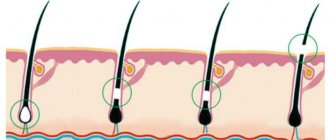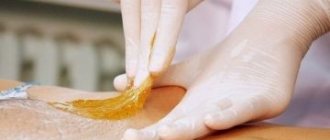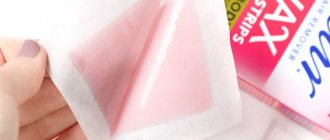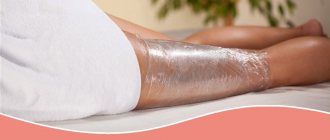Dark hair on the legs is a problem that is relevant for women from a young age. They begin to actively grow even during puberty; during this period, teenage girls take a razor from their mother for the first time, exacerbating the problem. Light fluff quickly turns into dark and unattractive stubble, and the daily struggle for smooth skin begins.
Modern cosmetology offers three effective ways to remove leg hair at home or in a salon. Which method is the safest and most effective? Let's try to figure it out.
About hair removal
The hair removal procedure has become so popular in our time that it has received its own name. Any hair removal is now called epilation. The word comes to us from the French language - épiler (to remove hair).
The essence of the hair removal procedure is that the hair follicle is destroyed in one way or another and the hair stops growing. Or the hair is removed from the roots.
Removing leg hair is not difficult, there are enough ways, and this is a definite plus. The downside is that most of these methods cause pain.
Another disadvantage of hair removal is that the hair on your legs will grow back after some time. That is, the procedure will have to be performed constantly. Or, as in the case of laser hair removal, you need to complete a certain course.
Contraindications for depilation
Any depilation other than shaving is contraindicated:
- for diabetes mellitus, since people who suffer from it have slow healing injuries and may have septic complications;
- with pronounced varicose veins;
- for any neoplasms in the area of depilation (papillomas, warts, moles);
- with individual intolerance to cream/wax/sugar paste;
- during exacerbation of infectious or viral diseases.
Only depilatory creams are contraindicated for pregnant and lactating women. Such products cannot be used because of their active chemical composition, which can easily cause allergies. There are no restrictions on the use of other methods. It should be remembered that almost all procedures are painful and in the last months of pregnancy it would be better to avoid wax and sugar, for example, in favor of shaving. A woman should discuss the implementation of a particular procedure with her leading doctor.
Depilation is not contraindicated for a pregnant woman, but she must avoid creams with chemical composition.
Ways to remove hair on legs
A simple and painless way is to shave your legs. This is the most basic way to get rid of hair. Does not require special preparation, special expenses, completely painless.
You can easily remove any hair on your legs, as long as you have a razor and soap. Most women resort to this method of solving the problem.
There is only one downside to basic shaving of legs - your legs will not be smooth for very long. After one or two days, the hair on your legs begins to grow. Maybe this is self-hypnosis, but it seems that the more often you shave your legs, the more abundantly the hair begins to grow, its structure changes, and it becomes stiff.
On the face
Excess facial hair can be a concern for both sexes. If this is the norm in men, then in women it may indicate a hormonal imbalance.
Chin
Representatives of the stronger sex constantly regulate the growth of hair on their chin by shaving. If women are faced with the presence of single hairs in a given area, they most often resort to plucking them with tweezers.
Above the lip
For some men, a mustache growing above the lip is an organic addition to the image. If such a deficiency appears in women, they begin to immediately fight it. In this case, it is important not to shave the hairs, otherwise they will grow harder and darker.
Hair removal with wax
Photo: Yandex.Pictures
You can remove hair on your legs using wax; this is one of the most common methods. Epilation using wax is divided into three technologies: hot, warm and cold hair removal.
Cold waxing
A method of hair removal using special wax strips. Using friction, warm up the wax strips in your hands and stick them on your feet. Then, with a sharp movement against the hair growth, tear off the strips. This method of removing leg hair is one of the most painful.
Warm waxing
To depilate using this method, you will need talc (baby powder), depilatory strips, and a wax cartridge.
Warm depilation wax is sold in special cartridges with a roller. The cartridge is a small container filled with frozen wax.
The day before the procedure, your feet should be prepared and exfoliated with a scrub. Before depilation, wash the skin and let it dry.
Apply baby powder or talcum powder liberally to the area where leg hair will be removed. This is done to protect the skin from possible wax burns.
Before use, heat the wax cartridge in a vertical position to a temperature of 39 °C. This can be done in a steam bath, in special wax melters or in a microwave oven.
Apply heated wax from the cartridge to the area of skin along the hair growth. Stick a depilatory strip on top and it should be longer than the applied wax strip. Press and smooth the strip, following the movements of the hair growth.
With a sharp and confident movement, tear off the depilatory strip in the direction of hair growth.
Wax cartridges for warm depilation have three different consistencies. It is difficult to say definitely which one is the best. You can only determine which wax is right for you through experience.
Classic wax is suitable for the most delicate areas of the skin. Ideal for removing fine to medium hair.
Cream wax is a dense and elastic wax mass. Ideal for sensitive and dry skin. This type of wax removes leg hair completely from the roots. The method is painful.
Gel wax is the lightest and most transparent, it has a synthetic base, it is economical and hypoallergenic.
Hot waxing
Of all types of wax depilation, this one is less painful. A hot mass of wax applied to the skin warms up the skin and expands its pores, so hair can be pulled out more easily. But if the procedure is performed ineptly or the temperature of the wax is too high, burns are possible.
The procedure will require special depilatory wax, talc or baby powder, a spatula for applying wax, and depilatory strips.
For this type of depilation, wax is sold in briquettes and must be heated for the procedure. To carry out a hot wax procedure, strict control of the wax heating temperature is necessary. Therefore, it is necessary to purchase a special wax melter.
And just as in the previous case, the day before the procedure, preliminary treatment of the legs with a scrub is necessary. Before performing depilation with hot wax, sprinkle your legs generously with talcum powder or baby powder.
Then apply hot wax along the hair growth with a spatula and a depilatory strip on top. Smooth the strip and press it along the hair growth and pull it off with a sharp movement against the hair growth.
Below is a comparison table of the three types of waxing.
| Action | Cold hair removal | Warm hair removal | Hot hair removal |
| Wax temperature | 36°C | 40 to 45 °C | 42 to 60 °C |
| How to warm up wax | Warming in the hands | In a water bath. In a wax melter. In the microwave. | Special furnace for wax melting with temperature control |
| Waxing method | Wax strips | Wax cartridge | Putty knife |
| How to remove leg hair | Tear off the wax strip against the direction of hair growth | Tear off depilatory strips against hair growth | Tear off strips against hair growth, or remove hardened wax with your hands against hair growth. |
| Leg hair length | From 5 mm | From 5 mm | 2–5 mm |
| Difficulty of the procedure | Low | Average | High |
| Possible complications and disadvantages | Hair breaks off, additional shaving is required | Hair breaks off, shaving may be required | Burns, severe skin irritation. |
How to avoid skin irritation
Any method of depilation (except for using cream) injures the top layer of skin, although only slightly. Microcracks are invisible and do not bother you at all. If the skin was disinfected before the procedure, they will simply heal without any side effects. If hygiene rules are violated, there is a risk of skin irritation due to the onset of the inflammatory process. The risk of infection is significantly higher if you wax without first removing ingrown hairs. Places where they have not yet sprouted, but have gone under the skin, are themselves foci of inflammation. With them, any depilation will be, firstly, very painful, and secondly, with consequences. Therefore, such hair needs to be removed a week or two before the procedure. If there are few of them and the inflammation is insignificant, you can do everything at home: trim the boil and pull out the hair with tweezers, then disinfect the wound. If pus has already appeared, you need to consult a doctor for help.
To prevent ingrown hairs, massage the scrub into areas where you regularly wax. A mixture of aspirin (2 tablets in 0.25 cups of water) and glycerin (4-5 drops) can help them germinate. The solution is applied 3 times a day for a week after the procedure.
On sensitive skin, depilation can cause a pustular rash, which can be treated within a few days with salicylic or boric acid. If your immune system is weakened, a herpes rash may appear on your legs, which can be treated with compresses with a decoction of calendula or chamomile flowers.
Skin irritation is a sign of an allergy or inflammation, it will not go away on its own, it requires medications
Irritation often occurs from synthetic clothing. Home hair removal has a big advantage: you don’t need to get dressed and go home immediately after the procedure. You can walk around with bare legs for half an hour. Then for 2-3 days you should choose loose clothing - trousers or skirts made from natural fabrics.
Hair removal using an epilator
You can remove leg hair using an electric epilator. The first procedure is quite painful; the pain can be compared to hundreds of tiny needles that simultaneously dig into the skin. It's painful, but you can endure it.
Before the hair removal procedure, you can warm up the skin with a scrub, the pain will be less. An undoubted advantage of using an epilator is that pain after the first procedure decreases and disappears over time.
New hair on the legs grows thin and sparse. It is enough to perform the procedure once a week, that is, regularity is necessary. The epilator movements should be carried out against hair growth. If the hair on the legs is difficult to remove, the movements can be repeated in those areas where the hairs remain.
After this type of hair removal, skin irritation occurs extremely rarely, and new hair on the legs appears only after 2 weeks.
Traditional recipes for removing unwanted vegetation
There are many methods of hair removal using traditional methods. All of them are distinguished by their safety and good effectiveness. Moreover, using such methods, you will not need to spend a lot of money on expensive electric epilators or depilatory creams.
Hydrogen peroxide for hair removal
Hydrogen peroxide is an excellent hair bleaching agent.
Concentrates sold in pharmacies are weak, and their use will not contribute to the destruction of the hair root.
Hydrogen peroxide is often sold in the form of a 2–3% concentrate, but to completely remove unwanted vegetation, you must use a 5–10% solution .
To do this, you can purchase perhydrol (30%) and make a 6–7% aqueous solution from it.
Important! 30% perhydrol in its pure form can cause serious damage to the skin, so it can only be used in a diluted form.
Apply an aqueous solution of hydrogen peroxide to the skin of your feet 2 times a day . After a few hours, the hair will acquire a whitish tint, and over time it will disappear altogether. During procedures using hydrogen peroxide, the skin of your legs will not be affected by a sun tan. Ultraviolet radiation will be an excellent stimulator of hair loss.
Using soda
Baking soda or sodium bicarbonate is an essential substance in the human body that must be present in normal quantities to fuel leukocytes (white blood cells).
However, soda has a rather negative effect on the hair root. The fact is that sodium bicarbonate can destroy the hair root , causing it to fall out.
It is known that black hair is more resistant to chemical hair removal methods. However, baking soda will also work 98% on white hair.
To remove unwanted hair on the legs, soda in its pure form is not used. It is necessary to make an aqueous solution: add 1 tsp to a glass of boiled water. soda Moisten gauze in the resulting solution and apply it to the area of skin where you want to remove excess hair.
In order for the effectiveness of the procedure to reach its maximum level, it must be repeated from 3 to 10 times. Check your hair regularly. If the hairs become very soft, they can be removed using mechanical methods, now painlessly.
Hair removal with cream
This is a completely painless hair removal procedure, but it also has its downsides.
Only thin and weak hair is susceptible to the action of depilatory cream. The depilatory cream does not remove coarse, dark hair. This method is not suitable for every woman.
The second point is that the cream can cause intolerance. Therefore, a sensitivity test is necessary. Apply a small amount of cream to the forearm and remove after a few minutes. If irritation does not appear, the cream can be used.
Apply the creamy mixture to clean skin of the feet. Wait for the required duration of operation of the depilator, which is indicated in the instructions, then remove the cream with a scraper in the direction of hair growth.
At what age can you start hair removal?
In childhood and adolescence, excess hair does not cause problems because the hairs are light and thin (they are also called vellus hairs). Over time, they darken, become noticeable and hard, and also begin to prick and cause discomfort. Moreover, these changes occur quite early (at 12–14 years), during puberty, when the endocrine system is reconstructed. Hormones are responsible for hair growth. When the latter are not all right or a woman is just experiencing such a shift due to age-related characteristics, excess hair growth may be observed. Leaving everything as it is, guided by the fact that it is too early for a teenage girl to undergo hair removal, is wrong. If there is a problem, it needs to be solved.
Depilation will not cause any harm to your physical health, but smooth legs will definitely increase the level of internal comfort.
For the first time, a growing girl should acquire a razor or epilator, if funds allow. At the age of 14–15, you can try sugar and wax depilation. It is better to do the procedure in a salon so as not to inadvertently injure the skin and not force the child to endure unnecessary pain. It is better to use depilatory cream no earlier than 16 years of age, and all hardware techniques are practiced only after reaching 18.
For the first depilation, it is best to buy a razor or epilator, and then move on to other procedures
Sugar hair removal
Photo: Yandex.Pictures
An ideal option for home hair removal on legs. This method is similar to hot waxing and is less painful. You can prepare a paste for sugar depilation (shugaring) yourself, or purchase a ready-made product.
How to cook pasta
The mass can be prepared in a regular non-stick frying pan. You will need 6 tablespoons of sugar, half a teaspoon of citric acid crystals and 2 tablespoons of water.
Place the frying pan on the fire. Cook the mixture, stirring until it reaches the consistency of liquid honey. Do not allow the mass to burn; it should turn out an amber color.
Before applying the paste, feet should be treated with baby powder or talcum powder. It is better not to apply the paste with bare hands, but to wear latex gloves. Apply a small amount of paste to the area of skin along the hair growth and immediately remove with a sharp movement against the hair growth.
The advantages of sugaring include the fact that a small amount of paste can be reused to remove hair on other areas of the legs.
How to slow down hair growth at home
After removing all the hair, be sure to treat the skin with a folk or commercial remedy to slow down its growth.
Folk remedies
Alkalies and acids work well for this purpose. But it turned out that lemon juice or vinegar (in its pure form) is suitable for some, while dark laundry soap is suitable for others. Everything is individual, so you have to try at your own peril and risk.
Dark laundry soap can also be used as a hair growth retardant.
The method of using all folk remedies is the same:
- After removing hair, soap the treated area with laundry soap or rub in vinegar/lemon juice.
- Leave for 5 minutes.
- Wash your feet, dry and lubricate the skin with nourishing cream.
They say that if you treat your hair this way, within a couple of months it will become softer and lighter.
Photo gallery: budget and expensive drugs to slow down hair growth
Depilflax lotion relieves irritation and prevents ingrown hairs
Planta Elcaptain Cream to Prevent Germintation Hair soothes skin and prevents ingrown hairs
Skin Doctors lotion has a moisturizing effect
After using Almea Xreducer cream, hair does not grow until 5-6 weeks
Byly Moisturizing Cream and Hair Growth Inhibitor with papain soothes skin
Simone Mahler Soin Epil+ lotion prevents ingrown hairs
Payot Post Epil Le Corps cream with plant extracts relieves irritation and soothes the skin
Lycon Spa Hair on Strike cream relieves irritation Mary Cohr Deopil Crème lightens hair, makes it softer and thinner Phenomen-all lotion relieves irritation, makes the skin soft and velvety
Floresan Deep Depil cream gel relieves irritation and restores skin moisture balance
Laser hair removal
The dream of all women is to remove leg hair once and for all! Now it has become not a dream, but a reality. I'm talking about laser hair removal on legs.
Laser hair removal on the legs is a new, radical method of getting rid of unwanted hair on the body. Using laser radiation, hair follicles are destroyed and hair stops growing.
The method is very interesting and effective, but it also has disadvantages. You cannot do laser hair removal on your own at home. To remove leg hair, one procedure will not be enough.
Complete hair removal will require a series of treatments spaced three to six weeks apart. The number of procedures depends on the individual characteristics of the body; as a rule, six to nine procedures are enough. For complete hair removal you will need to pay an impressive amount.
Laser hair removal on the legs is just as painful as any aggressive hair removal method. Each person's pain threshold is different, so the concept of pain is very relative.
Nothing extra! How to finally get rid of unwanted hair
What an injustice with this hair! There are always not enough of them on the head, but in various other places, on the contrary, there are plenty! How to finally get rid of them?
Elena Gavrilova, gynecologist-endocrinologist, candidate of medical sciences, head of the department of rehabilitation and aesthetic medicine of the Federal State Budgetary Institution "National Medical Research Center of Endocrinology" of the Ministry of Health of the Russian Federation
Maria Lebedeva, cosmetologist
Are you tired of shaving your legs with a machine and pulling out hairs with tweezers and an electric epilator? And rightly so, because science has long invented a remedy that can permanently rid you of unwanted hair on your face and body.
Tradition with deep roots
Having smooth skin is the dream of many women. But by nature, few can boast of this. Especially Southern women, whose hair is thicker, darker and fuller than that of Northern and Asian women. It is not for nothing that it was in Arab countries that such methods of getting rid of excess hair as sugaring and threading, which are still in demand today, originated. What women do not do to remove hair in beauty salons and at home: hot and cold wax, resin, thread, pumice, sugar, caramel... And, despite the existence of long-term methods of combating excess hair, various methods of depilation (mechanical removal of the visible part of hair) -still find fans. Well, to each his own. After all, as cosmetologist Maria Lebedeva explains: “With constant mechanical removal, the hair becomes thinner, becomes softer, lighter and less frequent, and grows more slowly. But depilation also has significant disadvantages. After such exposure, the hairs begin to grow into the skin, and subsequently we have to deal with the problem of post-inflammatory hyperpigmentation.” In addition, this method is unlikely to be suitable for removing hair on the upper lip. “When you pull out hairs on your face,” says Maria Lebedeva, “they can, on the contrary, become stronger and their growth becomes more intense. This is due to the development of collaterals in the microcerculature after damage to the vessel that feeds the hair.”
Miracle cream or electric needle?
Unlike depilatories (hair removal creams), which last for a maximum of a week, there are hair growth inhibitors. There are a huge number of them, but only one cream, which contains eflornithine hydrochloride, has an officially proven effect. It does not remove hair, but it significantly slows down its growth. This remedy can be used on its own or in combination with other methods. In folk medicine, turmeric and unripe walnuts have long been used for the same purpose, but, of course, their effect has not been officially proven. An effective method for removing single hairs (especially blond or gray hair) is electrolysis. The method is based on the action of electric current (a needle through which the discharge passes is inserted into the hair follicle and destroys it). However, it is impossible to use this method on large areas of the body - the process is too long. And besides, it is painful; few can withstand it for a long time. In addition, this point technique requires highly qualified, virtuoso skill and experience from the master, otherwise you can get burns, scars and pigmentation.
Everyone will die, but I will remain
“Removing a hair follicle permanently is an almost impossible task. But with the help of a laser, you can ensure that the hair remains in an inactive state for a long time,” says doctor Elena Gavrilova. “In the 21st century,” she continues, “it is simply indecent to resort to some other, less effective, more complex and dangerous methods.” By the way, in most cases, when mechanically removing hair, you have to deal with its ingrowth into the skin and inflammation of the follicles (folliculitis), and the laser method not only does not increase this risk, but also protects against it, since the light radiation itself also has an additional aseptic effect. Electrolysis can lead to hyperpigmentation, and laser, on the contrary, is specifically used to get rid of it. Over the past five years, there have been huge changes in the field of laser hair removal. The effect that modern lasers help achieve is unimaginable to those used ten years ago. And although even the most powerful laser is unable to order hair to completely stop breaking through smooth skin, nevertheless, a full course of procedures can make you forget about this annoying problem for five years.
Myths about laser hair removal
Myth #1
: It's ineffective.
You need to undergo laser hair removal for years to see results. In fact.
This myth has very clear origins. There is a lot of non-professional equipment on the Russian aesthetic market. Beauty salons purchase low-quality or outdated lasers. A good European device costs from 2.5 million rubles, and Chinese analogues cost 200–300 thousand rubles. Their effectiveness is quite consistent with the price. There is another point. In some salons, in pursuit of profit, patients are asked to come for treatments at least once a month. And this is wrong. There is no need to go to the clinic once a month, but when the hair grows back, you need to plan your next visit. The fact is that effective laser hair removal is not possible at any time. There are only three phases of hair growth: anagen (active growth phase), as well as telogen and catagen (resting and dying phases, during which there is no longer any pigment in the follicle). Only hair in the anagen stage can be treated with laser. There are about 15–20% of these on the body. That is why it takes six to eight procedures to reach the winning end. Therefore, the decision when to come for the next procedure must be made individually. It depends on the individual hair growth rate, as well as on the specific area: hair grows faster on the face than on the legs, and faster on the legs than on the stomach. On average, after hair removal they grow back within one to three months. Then - even less often. It is undesirable to skip the next procedure - this reduces the effect. Before laser hair removal, you need to shave your hair so that the laser energy is not sprayed onto the entire hair, but is concentrated only at the root.
Myth No. 2.
Photoepilation is more effective and safer.
In fact.
Photoepilation is also good, but it is a more labor-intensive procedure (requires the application and further rinsing of the gel), and after it is performed, there may be swelling and redness on the skin. In addition, it usually requires a larger number of sessions. After all, this is not selective, but high-intensity light. Moreover, its effect is transdermal. If you set the parameters correctly, there will be no burn, but, nevertheless, there is such a risk. And laser hair removal is based on selective photothermolysis. The laser beam is selectively absorbed by the pigment of the hair follicle. The skin is not involved at all, and therefore is not injured. Laser hair removal requires minimal effort from the patient. To prepare for the procedure, you only need to remove hair from the surface of the skin. Between procedures, they can also be shaved or cut (but not pulled out!). After the first session, from 20 to 70% of hair falls out.
Myth No. 3.
The result of hair removal depends on which laser is used.
In fact.
There are only four types of lasers: ruby, alexandrite, neodymium and diode. But there are two gold standards for hair removal: alexandrite and diode (but only from global manufacturers and the latest generations). They are highly selective (act only on the hair pigment and not on the skin) and work close to the infrared spectrum (800 nanometers). Thanks to this, even if you set the strongest parameters, you cannot cause burns or even redness of the skin. Therefore, such lasers can remove the thickest hair, including in intimate areas. But it is important to focus not just on the type of laser, but also on its technical characteristics (long wavelength and high power). European devices have a power of at least 2500–3000 W, while Chinese devices have only 800 W.
Myth No. 4.
The laser will not help if your skin is dark and your hair is light.
In fact.
If the laser operates in the infrared spectrum, then even the patient’s belonging to the Negroid race is not an obstacle. But it really won’t remove blond or gray hair—they don’t have pigment. Only electrolysis can handle this.
Myth No. 5.
Laser procedures cannot be done in the summer.
Otherwise, you can develop hyperpigmentation. In fact.
A high-quality laser acts selectively only on the hair pigment, and not on the skin, and therefore does not cause hyperpigmentation. But the lighter the skin, the less painful and more effective the procedure will be. Therefore, you should not sunbathe for two weeks before and the same amount after. After the session, it is also better to refrain from visiting the bathhouse and sauna. Firstly, the sun and heat exposure themselves stimulate the hair follicles, and secondly, tanning the skin is inflammatory, and therefore the procedure on tanned skin will be more painful.
Myth No. 6.
Laser hair removal is painful and expensive.
In fact.
Minimal discomfort during the procedure is possible, because the destruction of the hair follicle occurs through intense heating. The nerve endings also receive some of the heat, so a slight tingling sensation is felt during the process. But these sensations cannot be compared with the pain from electrolysis. As for the price, this service is not cheap. But in the long run it will be more profitable than any mechanical methods of hair removal. After all, six to eight procedures will allow you to get rid of hair for years (for some, five, for others, seven or more).
Myth No. 7.
If the excess hair is due to hirsutism (excessive male pattern hair growth in women), the laser will not help.
In fact.
Laser hair removal is included in the medical standards for the treatment of hirsutism. But first, it is important to find out what causes hirsutism. If it's a family history or idiopathic hirsutism with no specific cause, that's one thing. But if it is associated with some disease, then you first need to take control and compensate for the underlying disease, and only then engage in hair removal. Then you can achieve good results. Therefore, before hair removal, the doctor must collect anamnesis and exclude (or confirm) endocrine causes.
Myth No. 8.
Laser provokes cancer.
In fact.
Over the 25 years that laser hair removal has been used in the world, not a single piece of evidence has been recorded confirming the danger of the method. However, there are contraindications to laser exposure. These are any acute conditions (including herpes), pustular diseases, skin wounds and exacerbations of chronic diseases. Light exposure can worsen their course.
BEFORE AS
Before having your hair removed by a cosmetologist, you must visit a gynecologist-endocrinologist. A possible connection between hirsutism and the disease is indicated by symptoms such as:
- increased hair growth in old age (this may raise suspicion of androgen-dependent tumors of the ovaries and adrenal glands);
- signs of virilization, including deepening of the voice, enlargement of the clitoris and muscle mass, acne, male pattern hair loss;
- irregular menstrual cycles, obesity, infertility (often occurs with polycystic ovary syndrome);
- thinning of the skin, rounding of the face, stretch marks on the abdomen (with Cushing's syndrome).
For a correct diagnosis, you may need a blood test for hormones, ultrasound of the pelvic organs, thyroid gland, MRI or CT scan of the adrenal glands and other studies. Possible causes of hirsutism
- PCOS (polycystic ovary syndrome).
- Congenital adrenal hyperplasia.
- Cushing's disease.
- Tumors of the ovaries and adrenal glands.
- Excess growth hormone.
- Insulin resistance.
- Taking certain medications.
Important
To choose a treatment strategy for hirsutism, it is necessary to confirm this diagnosis and determine the extent of the disease. For diagnosis, it is enough to calculate the points according to the special Ferriman-Gallwey table. Hair growth needs to be assessed in nine androgen-dependent areas: upper lip, chin, chest, shoulders, hips, upper and lower back and abdomen. If there are no coarse terminal hairs there, 0 points are given. The minimum hair growth is estimated at 1 point, the maximum at 4 points. From 0 to 8 points - no hirsutism, 8-15 - moderate degree of the disease, everything higher - moderate severity, more than 25 points - severe hirsutism. A severe degree is the basis for not only cosmetic, but also drug treatment (oral contraceptives, antiandrogens and other drugs can be used). In addition, lifestyle modification is also important - losing excess weight, quitting smoking (tobacco increases the risk of side effects from the medications used), avoiding thermal procedures and tanning.
Important information
Removing leg hair is not only painful, any hair removal procedure can cause irritation to the skin. Regular aftershave cream will help cope with irritation. In more serious cases, a compress of chamomile decoction helps.
✔ Brew one tablespoon of chamomile flowers with a glass of boiling water. Let it brew for half an hour. Soak a gauze pad in the solution and apply it to the irritated area. After ten minutes, remove.
You cannot remove leg hair by any aggressive method if you have varicose veins. Aggressive hair removal procedures are best done in the evening. Overnight, the skin will have time to recover and acquire an even color and well-groomed appearance.
How to properly wax your legs
The rules for depilating legs with each of the above methods are slightly different. However, for each of the procedures (except for wax hair removal), one irreplaceable rule remains: before starting the procedure, you need to take a hot shower with a scrub .
If the skin was damaged during depilation, it is necessary to use antiseptics or antibacterial agents. Do not forget about moisturizing the skin after the procedures ; for this you need to purchase special creams or oils.
The most important thing: no matter what hair removal method you use, follow the basic recommendations, and then there will be no problems.
Table: Advantages and disadvantages of different types of hair removal and depilation
| Hair removal method | Advantages | Flaws |
| Waxing |
|
|
| Sugaring |
| painful procedure |
| Enzyme hair removal |
|
|
| Hardware | high efficiency |
|











